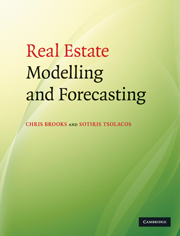Book contents
- Frontmatter
- Contents
- List of figures
- List of tables
- List of boxes
- Preface
- Acknowledgements
- 1 Introduction
- 2 Mathematical building blocks for real estate analysis
- 3 Statistical tools for real estate analysis
- 4 An overview of regression analysis
- 5 Further issues in regression analysis
- 6 Diagnostic testing
- 7 Applications of regression analysis
- 8 Time series models
- 9 Forecast evaluation
- 10 Multi-equation structural models
- 11 Vector autoregressive models
- 12 Cointegration in real estate markets
- 13 Real estate forecasting in practice
- 14 The way forward for real estate modelling and forecasting
- References
- Index
8 - Time series models
Published online by Cambridge University Press: 05 June 2012
- Frontmatter
- Contents
- List of figures
- List of tables
- List of boxes
- Preface
- Acknowledgements
- 1 Introduction
- 2 Mathematical building blocks for real estate analysis
- 3 Statistical tools for real estate analysis
- 4 An overview of regression analysis
- 5 Further issues in regression analysis
- 6 Diagnostic testing
- 7 Applications of regression analysis
- 8 Time series models
- 9 Forecast evaluation
- 10 Multi-equation structural models
- 11 Vector autoregressive models
- 12 Cointegration in real estate markets
- 13 Real estate forecasting in practice
- 14 The way forward for real estate modelling and forecasting
- References
- Index
Summary
Learning outcomes
In this chapter, you will learn how to
explain the defining characteristics of various types of stochastic processes;
identify the appropriate time series model for a given data series;
distinguish between AR and MA processes;
specify and estimate an ARMA model;
address seasonality within the regression or ARMA frameworks; and
produce forecasts from ARMA and exponential smoothing models.
Introduction
Univariate time series models constitute a class of specifications in which one attempts to model and to predict financial variables using only information contained in their own past values and current and, possibly, past values of an error term. This practice can be contrasted with structural models, which are multivariate in nature, and attempt to explain changes in a variable by reference to the movements in the current or past values of other (explanatory) variables. Time series models are usually atheoretical, implying that their construction and use is not based upon any underlying theoretical model of the behaviour of a variable. Instead, time series models are an attempt to capture empirically relevant features of the observed data that may have arisen from a variety of different (but unspecified) structural models.
An important class of time series models is the family of autoregressive integrated moving average (ARIMA) models, usually associated with Box and Jenkins (1976). Time series models may be useful when a structural model is inappropriate.
- Type
- Chapter
- Information
- Real Estate Modelling and Forecasting , pp. 225 - 267Publisher: Cambridge University PressPrint publication year: 2010



